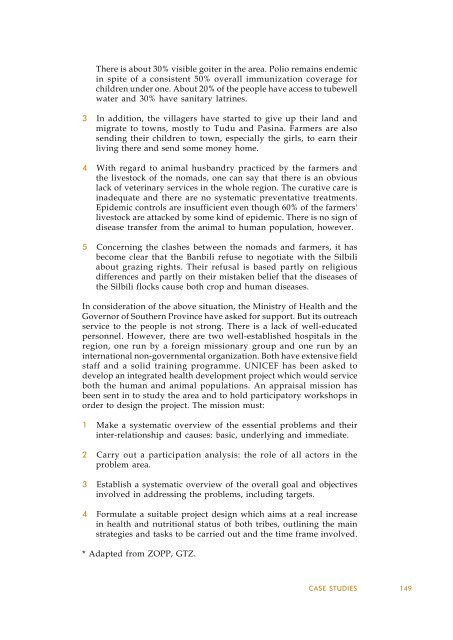VIPP_Unicef
VIPP_Unicef
VIPP_Unicef
Create successful ePaper yourself
Turn your PDF publications into a flip-book with our unique Google optimized e-Paper software.
There is about 30% visible goiter in the area. Polio remains endemic<br />
in spite of a consistent 50% overall immunization coverage for<br />
children under one. About 20% of the people have access to tubewell<br />
water and 30% have sanitary latrines.<br />
3 In addition, the villagers have started to give up their land and<br />
migrate to towns, mostly to Tudu and Pasina. Farmers are also<br />
sending their children to town, especially the girls, to earn their<br />
living there and send some money home.<br />
4 With regard to animal husbandry practiced by the farmers and<br />
the livestock of the nomads, one can say that there is an obvious<br />
lack of veterinary services in the whole region. The curative care is<br />
inadequate and there are no systematic preventative treatments.<br />
Epidemic controls are insufficient even though 60% of the farmers'<br />
livestock are attacked by some kind of epidemic. There is no sign of<br />
disease transfer from the animal to human population, however.<br />
5 Concerning the clashes between the nomads and farmers, it has<br />
become clear that the Banbili refuse to negotiate with the Silbili<br />
about grazing rights. Their refusal is based partly on religious<br />
differences and partly on their mistaken belief that the diseases of<br />
the Silbili flocks cause both crop and human diseases.<br />
In consideration of the above situation, the Ministry of Health and the<br />
Governor of Southern Province have asked for support. But its outreach<br />
service to the people is not strong. There is a lack of well-educated<br />
personnel. However, there are two well-established hospitals in the<br />
region, one run by a foreign missionary group and one run by an<br />
international non-governmental organization. Both have extensive field<br />
staff and a solid training programme. UNICEF has been asked to<br />
develop an integrated health development project which would service<br />
both the human and animal populations. An appraisal mission has<br />
been sent in to study the area and to hold participatory workshops in<br />
order to design the project. The mission must:<br />
1 Make a systematic overview of the essential problems and their<br />
inter-relationship and causes: basic, underlying and immediate.<br />
2 Carry out a participation analysis: the role of all actors in the<br />
problem area.<br />
3 Establish a systematic overview of the overall goal and objectives<br />
involved in addressing the problems, including targets.<br />
4 Formulate a suitable project design which aims at a real increase<br />
in health and nutritional status of both tribes, outlining the main<br />
strategies and tasks to be carried out and the time frame involved.<br />
* Adapted from ZOPP, GTZ.<br />
CASE STUDIES<br />
149


